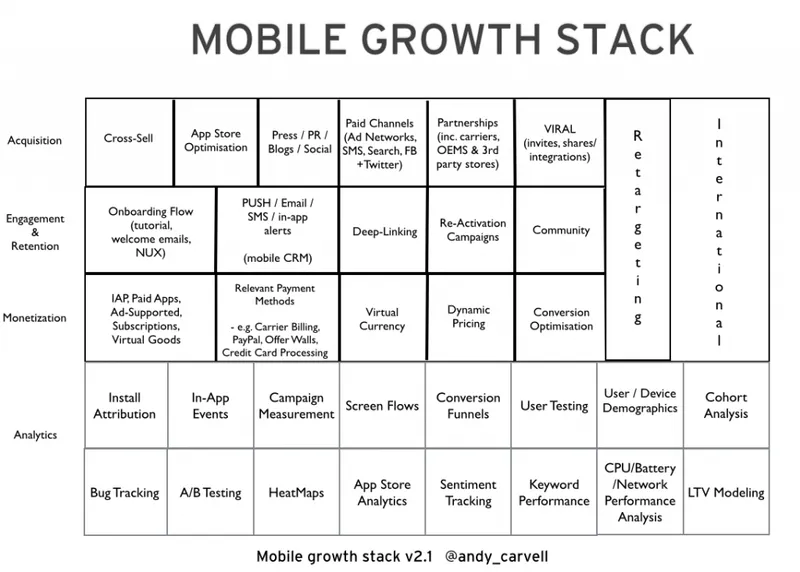The Mobile Growth Stack: A lightweight framework for strategic mobile growth
When formulating a mobile growth strategy for your business, what factors should you take into account? What tools and techniques should you consider applying? How will you measure success and effectively scale what’s working?
When considering how to effectively, sustainably grow the userbase for a mobile product or service, there is no one-size-fits-all solution; it’s useful to take a holistic approach. I use something I refer to as the ‘Mobile Growth Stack’ to conceptualize the various levers and catalysts for growth in the mobile ecosystem:

Unpacking the Stack
The aim of the stack is to encourage consideration of all the included elements when devising a growth strategy. The message is not that one must drive activities in all sections of the stack to deliver growth, but that a successful growth strategy will likely consist of a subset of these elements and be mindful of the others. Some elements will necessarily be more or less relevant/effective for particular apps or businesses, or at different stages of the business.
An effective growth strategy will play to core strengths, while developing nascent competencies and technologies to deliver incremental growth over time.
Many of the elements in the stack are mobile-specific (push notifications, ASO, etc.) though some are not inherently ‘mobile’ and could readily be applied to growing a web-based or cross-platform product or service.
The stack has three primary layers, representing key business goals: Acquisition, Engagement/Retention and Monetization. Depending on the stage of the company lifecycle, specific layers may receive more attention or emphasis, but a successful business will need to deliver across all layers at some point.
Why include monetization at all in a growth framework? What do in-app purchases or adverts have to do with growth, after all? Rovio demonstrated the value of holistic thinking (as well as a good understanding of the differences between iOS and Android) when it released Angry Birds as a paid app on iOS and free (ad-supported) on Android. Had Angry Birds been a paid app on Android, its growth would have been considerably less impressive. It’s important to acknowledge that monetization decisions can have a major impact on growth trajectory.
Internationalization as a Multiplier
‘International’ growth is a broad topic that transcends any particular layer in the framework. Growth tactics in international markets are likely to be quite specific to your product/service and the competitive landscape in which it operates. However, done right — which likely will mean more than simply translating your app and store listing, though this would be a good place to start — internationalization will act as a catalyst for your acquisition, engagement and monetization efforts and hence complement your activities across the board
A strong international strategy will likely take into consideration supporting locally-relevant payment methods, integration with the most popular social networks in target regions, country-level or regional partnerships and so on, and hence works in combination with many of the individual cells in the stack.

Retargeting can be applied to all three layers
Effective re-targeting of users or potential users with targeted messaging can be used to drive acquisition, increase engagement, or to boost monetization; it cuts across all three layers. Ideally, a growth marketer would be able to pinpoint users who had dropped out of — or got stuck in - any stage of the conversion funnel and deliver a message that might nudge them towards a goal.
With so much action happening in the world of Mobile and Apps et al, we bring to you MobileSparks 2014 (December 19, Bengaluru) - a conglomeration of all-things-mobile. We are bringing in an amazing lineup of speakers, with insights and content that you'll be able to convert into action. Book right away.
And if you want to showcase your mobile startup to the best of the industry, VCs and developers, APPLY NOW!
World-Class Analytics as a Foundation
Changes, whether they be adding features to your app, updating your app store copy, or spending money on a Facebook app-install campaign, should almost never be made without the necessary instrumentation and testing infrastructure around them to measure the effects and optimize towards your goals. If you’re making changes, hoping for the best and moving on to the next item in a backlog, you’re likely going to burn a lot of time & money with suboptimal impact.
A firm foundation of analytics and a commitment to a test->measure->scale approach to growth is critical to any serious growth strategy and hence it gets its own section in the framework.
Analytics and insight are not just another box to tick off when considering your strategy; they inform the strategy.
As with the rest of the cells, it’s not necessary for your analytics stack to include every element included in the framework, but it’s worth considering developing or buying-in competencies in the areas listed.
Retention & Engagement are a good place to start
Despite being the middle layer of the stack, nailing engagement & retention are likely to be the initial focus of any new app in the early days. Assuming the product itself is appealing to users (which is a huge assumption), engagement can be effectively increased by working hard to optimize the new-user experience, informed through analytics and user testing. Carefully crafted welcome emails and in-app tutorials are two methods to help onboard new users effectively.
Building a community around the product or service helps increase stickiness; nurturing the most passionate users and providing tools and forums (both online and real-world) to connect users who enjoy the app can drive engagement at all levels and provide inspiration to new users.

Re-activation of lapsed users can be hard to achieve, especially in the fickle era of mobile, where the barrier to removing an app is low and the likelihood of discovering a competitive offering is high. Therefore, it’s typically more valuable to concentrate on retaining users before they become dormant. However, bringing back a lapsed user may still prove more cost-effective than acquiring a brand new one.
Customer Relationship Management (CRM) is another huge topic in its own right and there are many solutions in the marketplace that aim to address it. Services such as Kahuna, Localytics, AppBoy, Capptain, amongst many others, aim to simplify the process of delivering targeted, timely and personalized messaging to users to boost engagement. As with all elements of the stack, CRM will be more applicable to some apps and businesses than others.
The risk of annoying users with messages they don’t care about is high, so every interaction with a user should be valuable to them (as demonstrated by data demonstrating long-term increased engagement from these interactions) and based on a deep understanding of the user. Allowing users to fine-tune at a high granularity the type of messages they receive will provide a valuable feedback loop to this process and reduce the risk of churn.
Deep linking has been touted as the next big thing for app engagement. Whilst this might be true in some cases (particularly if your app lends itself to linking to individual content items), it will likely not be universally applicable. It’s worth considering how your app could leverage deep-linking to drive more engagement or discoverability.
Acquisition is not (just) about buying users
The term ‘user acquisition’ is all too often conflated with performance marketing. Paid acquisition is often an important and impactful part of a broader growth strategy and can significantly accelerate growth. It can also be an expensive way to learn tough lessons about an app’s lack of underlying appeal or stickiness.
Since almost all users will take the final decision to download the app whilst at the store page, App Store Optimization is likely to be an essential activity, both for conversion (through optimized assets and messaging) and discovery (through careful keyword selection).

The illusive concept of ‘virality’ is hard to generate artificially; ultimately, sustained viral growth is likely to be rooted in a strong product or engaging content. However, paying careful attention to content sharing, item gifting, or invitation flows cultivates the right conditions for virality to occur.
Partnerships with brands or networks that can help your app reach new users whilst brining value to the partner can be huge for increasing reach and provide added value to customers of both, such as the SoundCloud + Sonos partnership.
Additional buzz created by social media, PR, content marketing, etc. can be harder to measure in terms of direct impact on growth, which often leads to it being overlooked by by ‘growth hacker’ teams, or treated as a separate branch of marketing. Nevertheless, such activities can build measurable brand awareness, ultimately leading to increased user acquisition.
Monetization shouldn’t be an afterthought
Even if your company is in ‘growth phase’, concerned with building a userbase rather than monetizing it, it’s usually desirable to make money at some point. Taking into consideration such things as how the app will be monetized, what payment methods or billing integrations might be required, etc. could lead to fundamental shifts in the way the product is positioned and which features are pushed within the app.
Once users begin to spend money on or within the app, LTV modeling takes on a critical importance and informs when and how much to scale performance acquisition.
To emphasize the interconnected nature of the layers in the stack, consider the impact of deploying overly-aggressive banner advertising within your app; monetization will likely increase in the short term, but possibly at the expense of increased churn and reduced virality. Similarly, charging $1.99 for the app might reduce acquisition considerably, but lead to far higher returns in exchange for more modest growth.

Whilst there is still a place for paid apps that require a one-off purchase, the freemium model is fast becoming de-rigueur across the app landscape. For an in-depth and actionable explanation of the freemium app model, I recommend checking out Freemium Economics, by Eric Suefert.
Virtual goods provide a very scalable way to monetize if you can find something suitably appealing and relevant to your audience and are not limited to games. The fast-growing LINE messenger app monetizes very well with virtual ‘stickers’, offering personalization to users.
Employing a virtual currency brings both complexity and fine control over the app economy and may make dynamic pricing or price experimentation easier to achieve. Whilst virtual currency is usually considered the preserve of games, there are other notable examples, including Skype Credits which are sold in bundles to provide talk-time to landline and mobile telephones.
Iterating on the Stack
The Mobile Growth Stack is very much a work-in-progress; it’s been through several iterations already. I’d love to hear from other growth practitioners and mobile experts; is the above framework useful when applied to your own strategic thinking? How could it be improved? What changes would you make?
________________________________
Editor's note: Andy Carvell works on growth topics at SoundCloud.

The views expressed here do not necessarily represent those of his employer.
The post appeared here first, and published with permission.







